Abstract
1. The imidazole-containing compounds carnosine and homocarnosine, endogenous to skeletal and cardiac muscle, have been tested for effect on the contractile behaviour of chemically skinned (saponin or Triton X-100) skeletal and cardiac muscle. 2. Carnosine, at millimolar concentrations which are near physiological for many skeletal fibres, and in a concentration-dependent fashion, shifts the curve relating [Ca2+] to steady-state tension to lower [Ca2+] in both skeletal (frog but not crab) and cardiac (rat) muscle preparations. 3. Of other imidazoles endogenous to heart, homocarnosine is somewhat more effective, while N-acetyl L-histidine is much less so. 4. The maximum level of Ca(2+)-activated force is increased significantly by homocarnosine in cardiac trabeculae. 5. We propose that the cellular imidazoles related to carnosine are natural 'Ca2+ sensitizers' in striated muscle. Alterations in their levels as a result of disease or training, and between different fibre types, may contribute to differences in contractile performance of the intact tissues.
Full text
PDF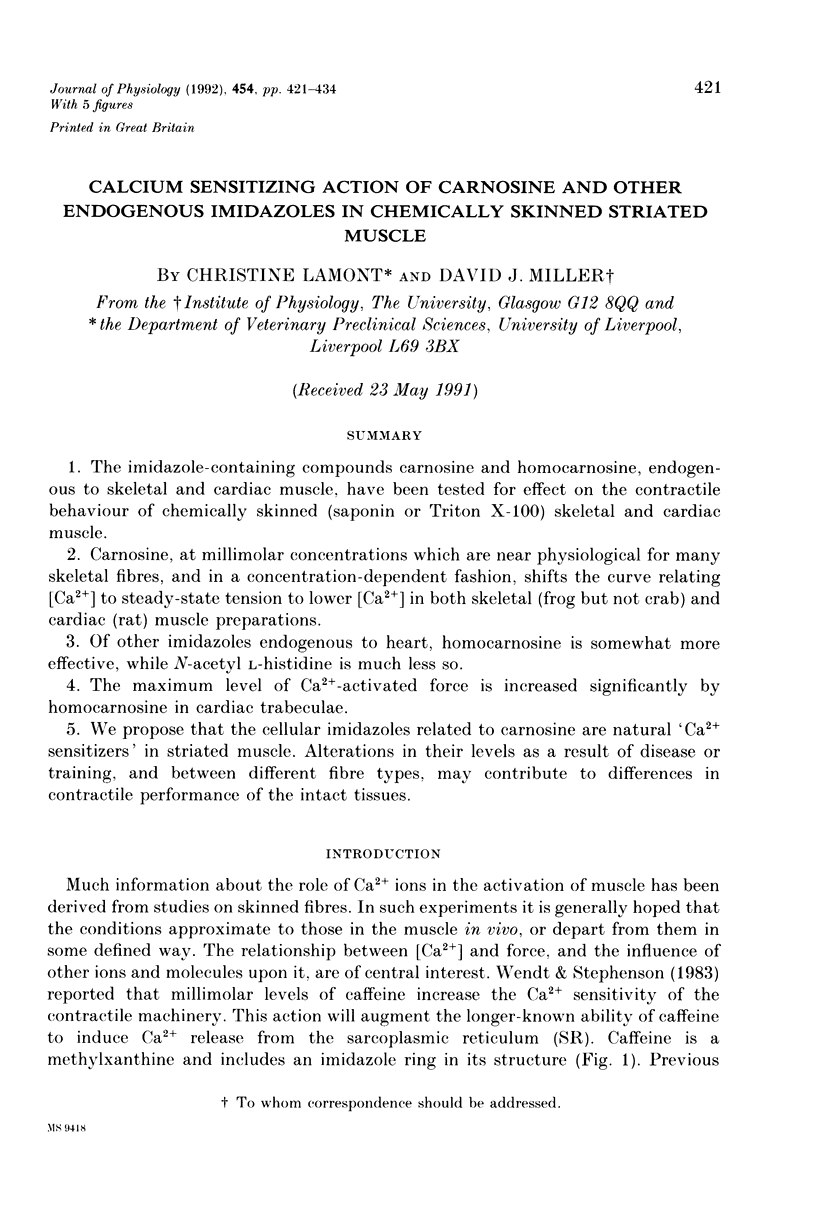
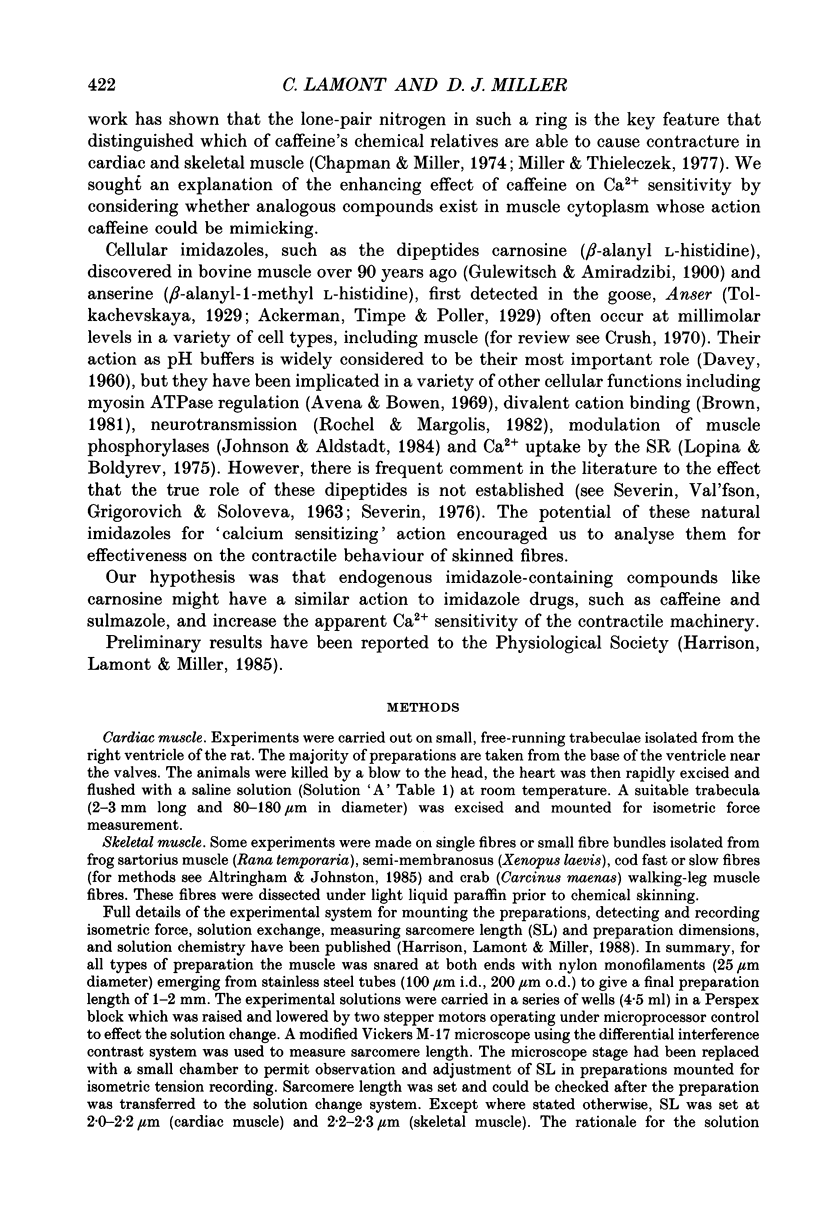
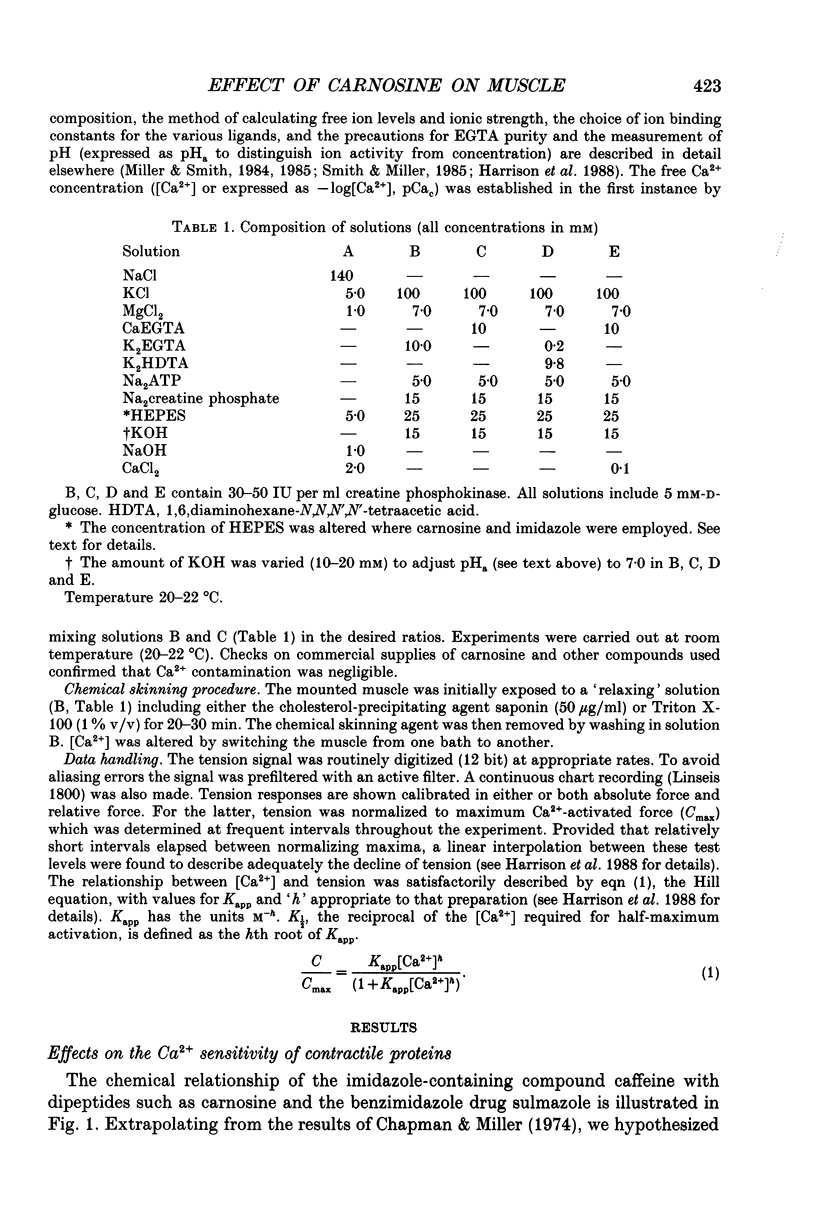
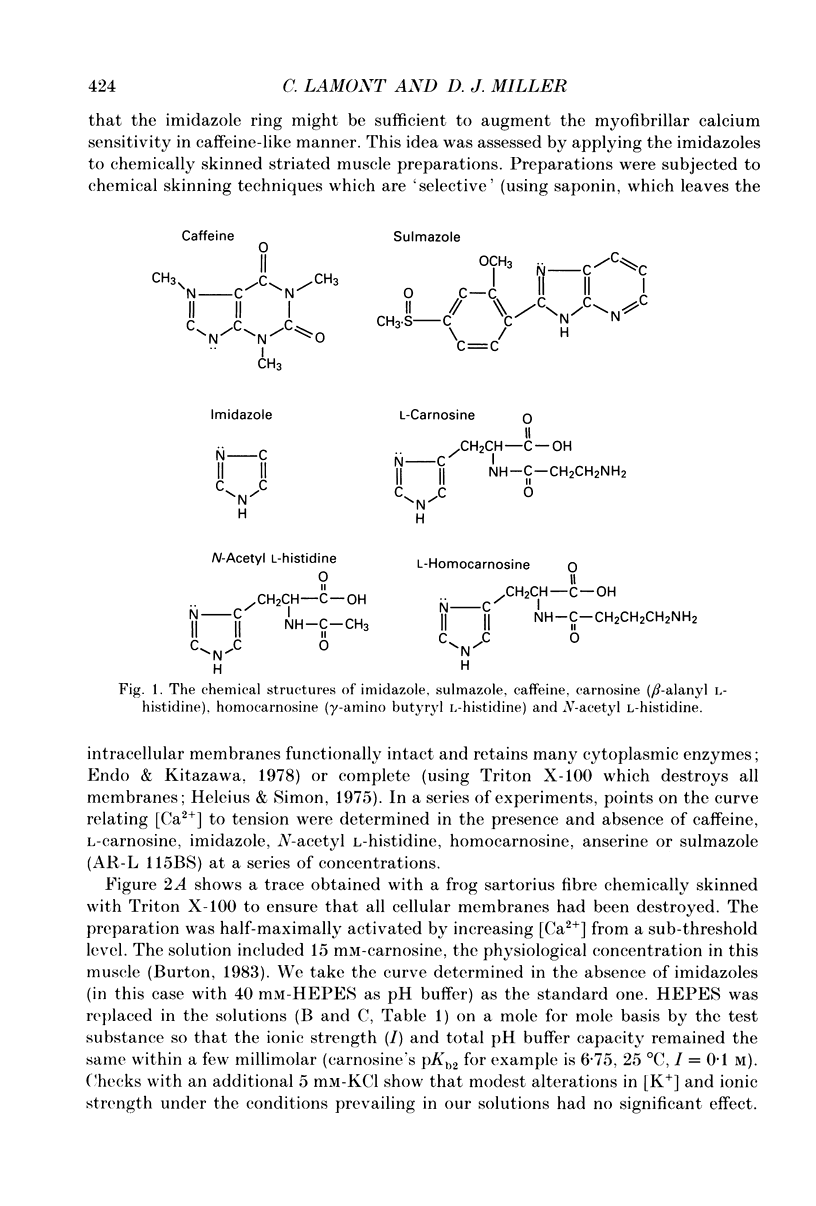
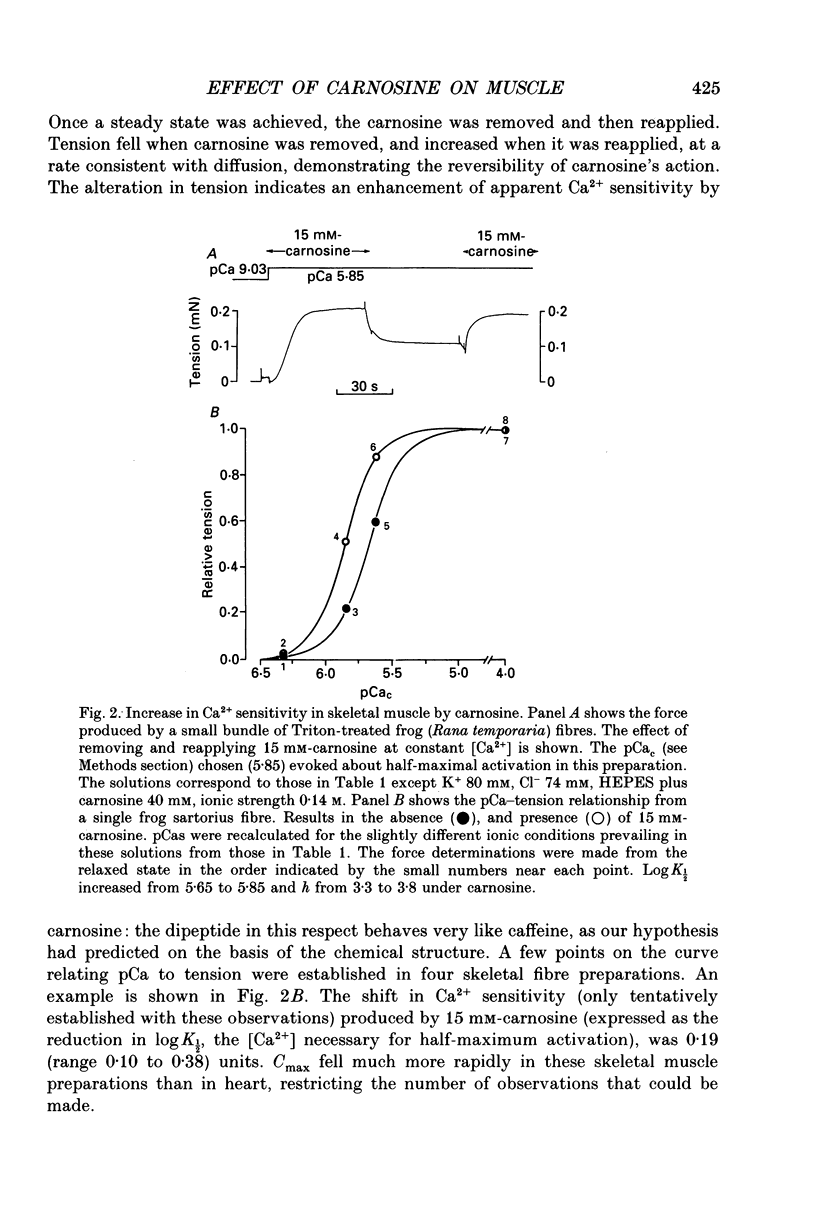
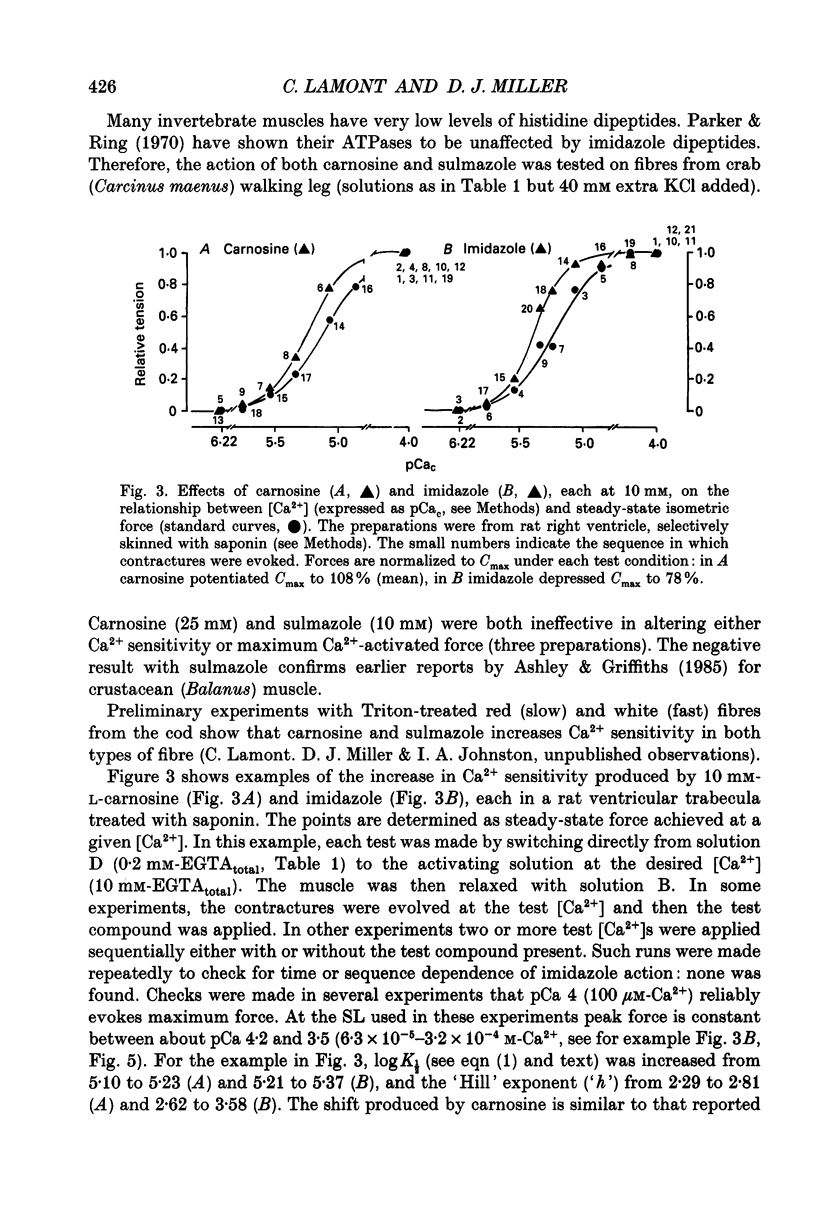
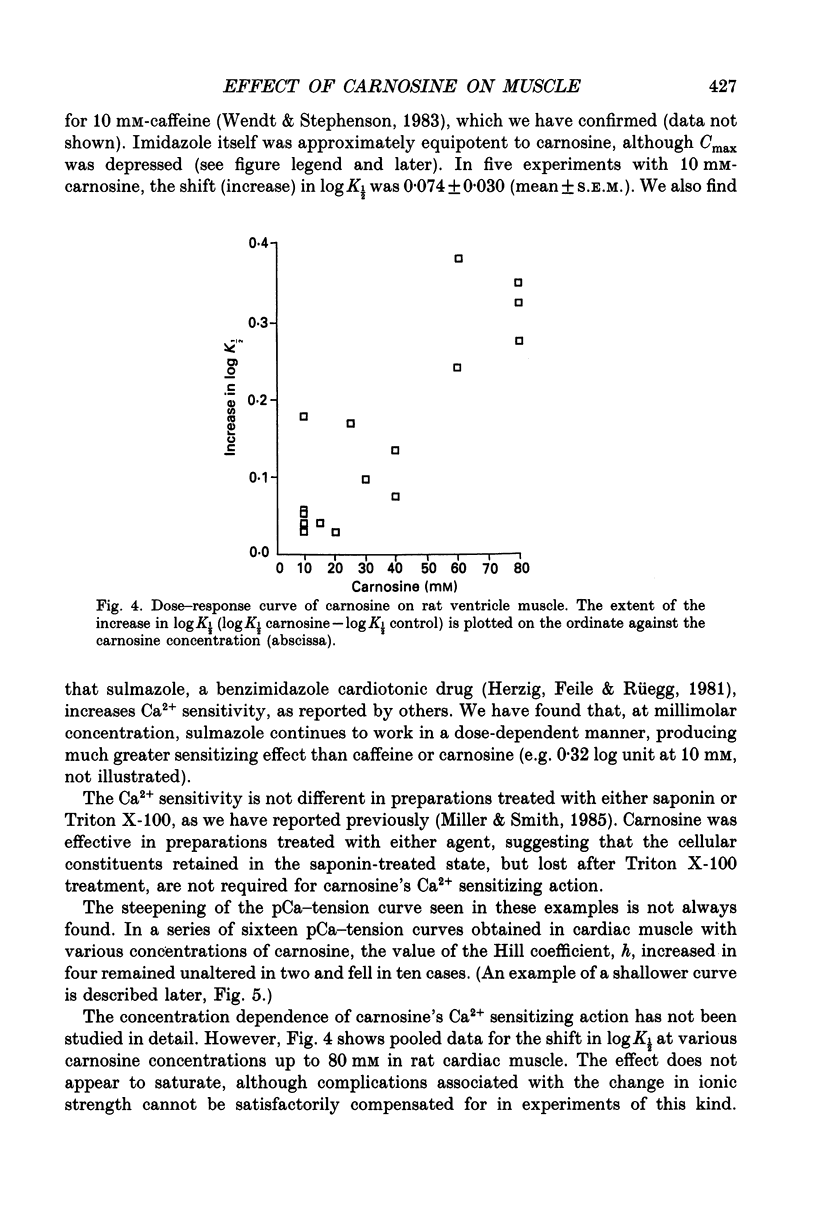
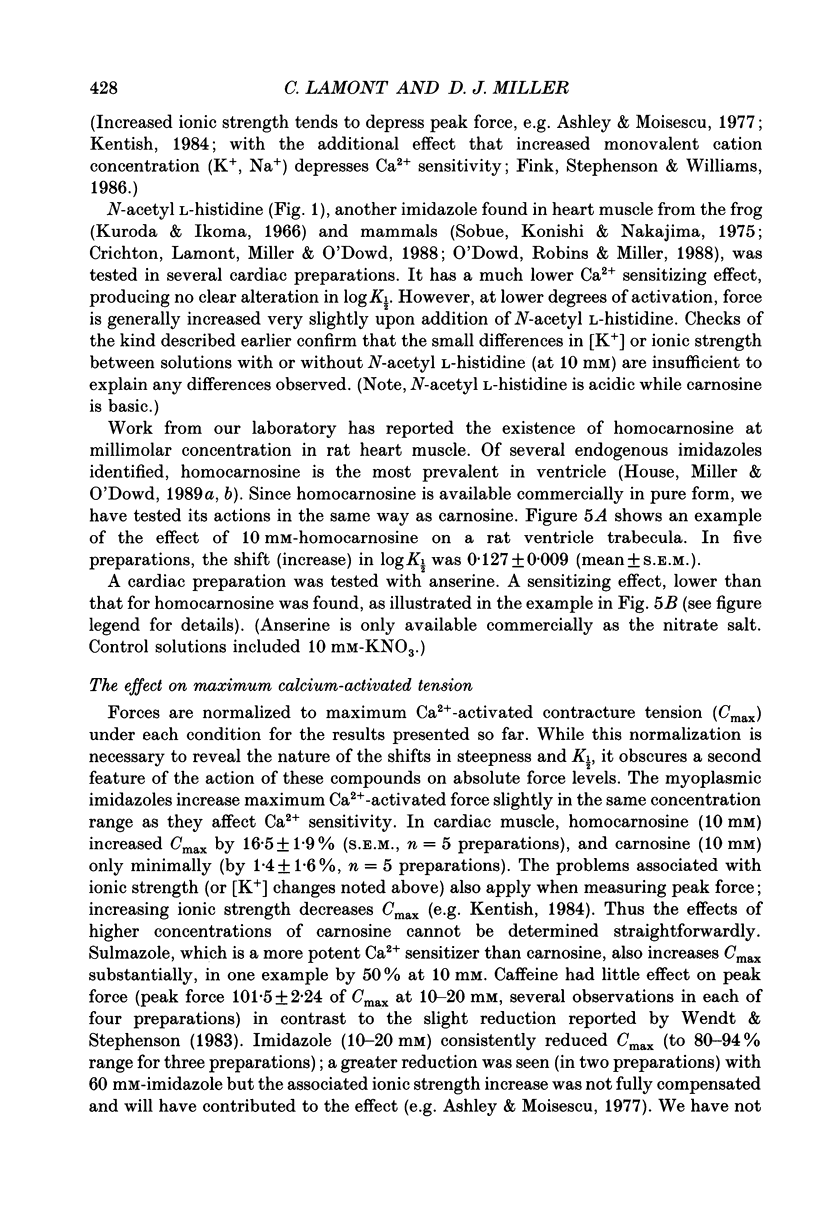
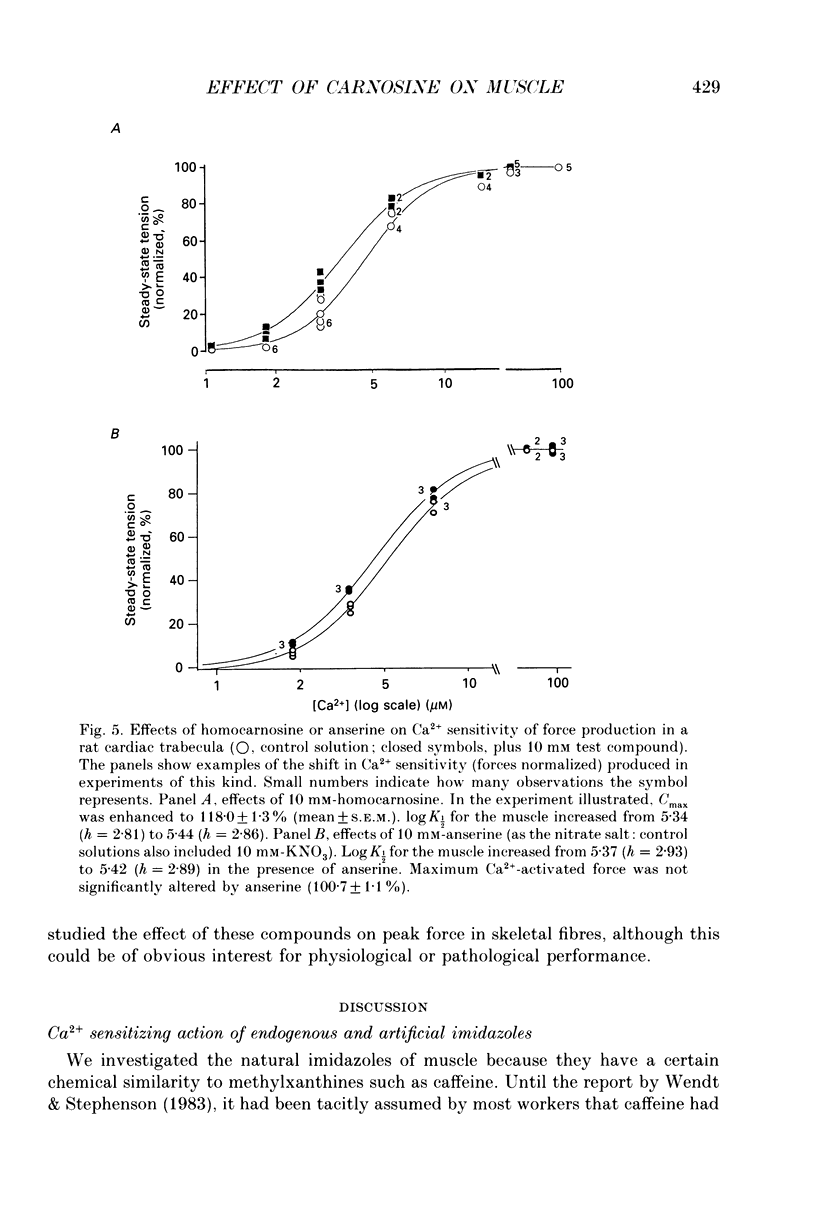
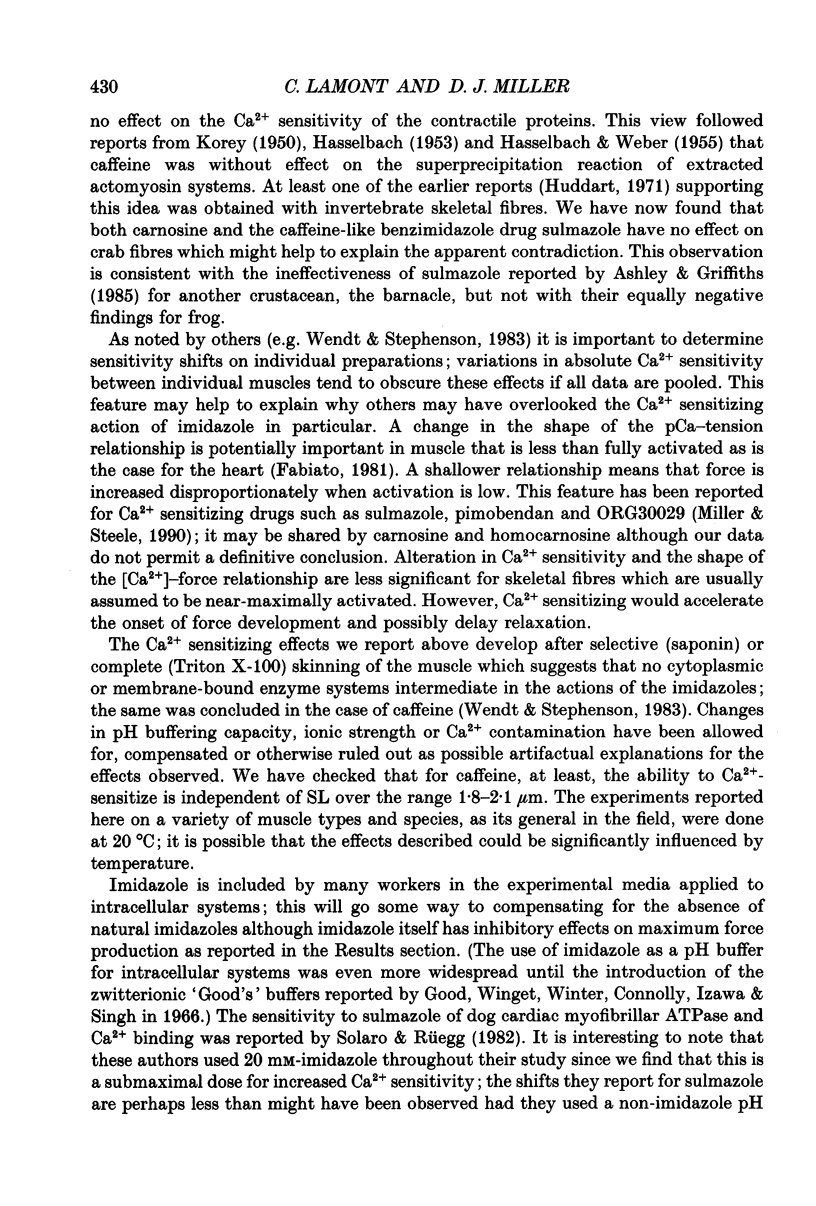
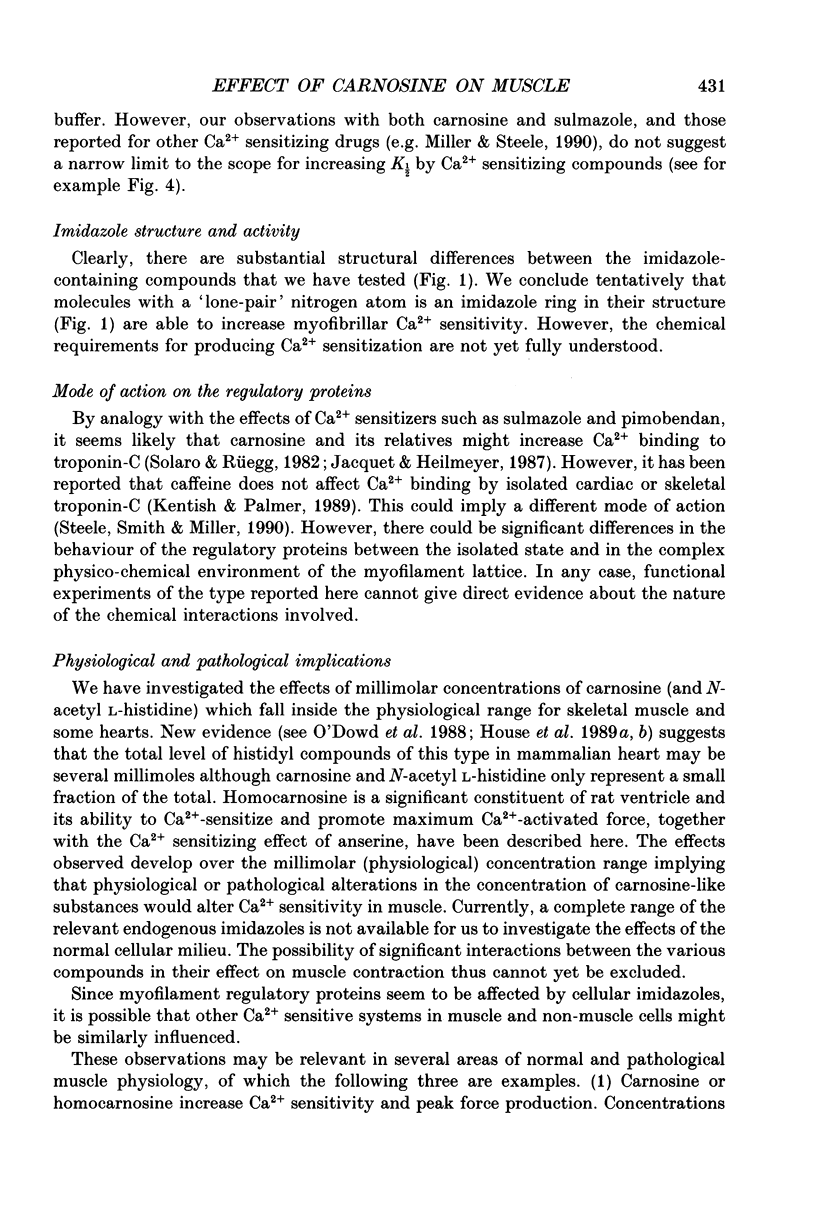
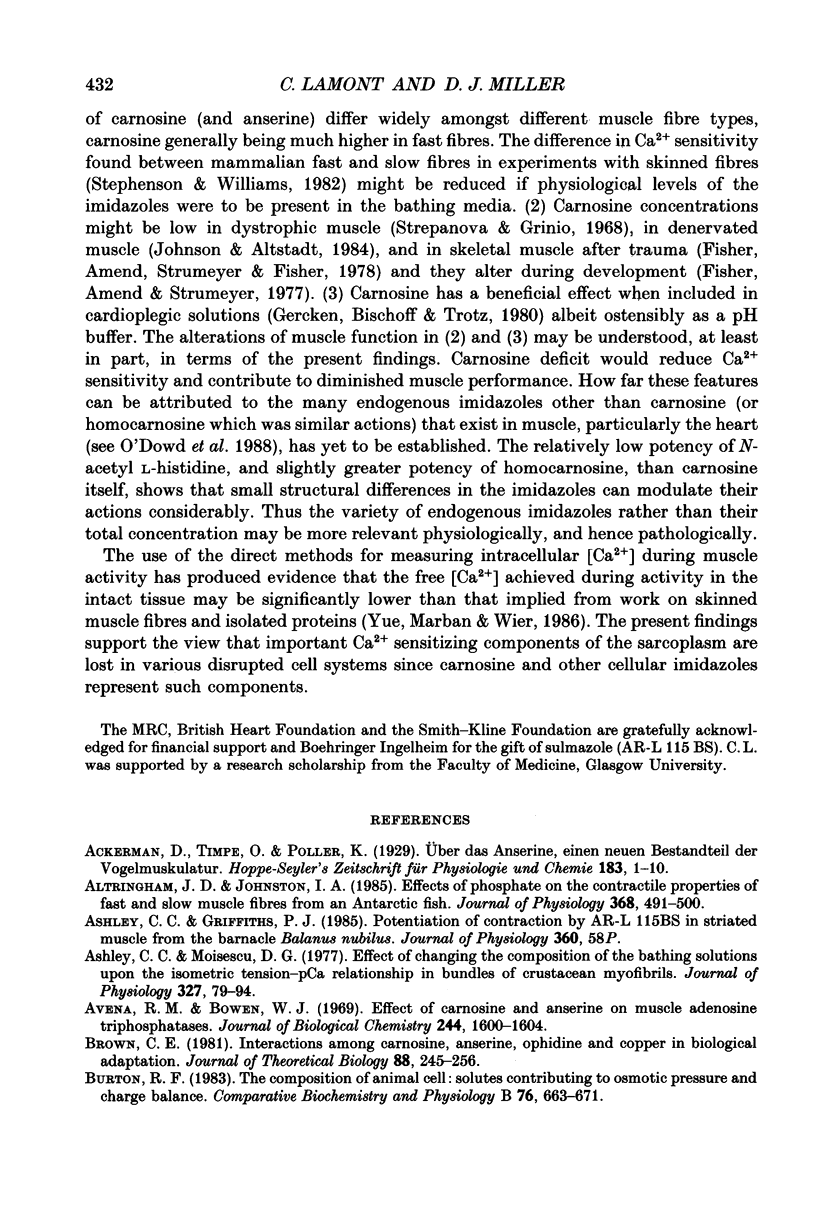
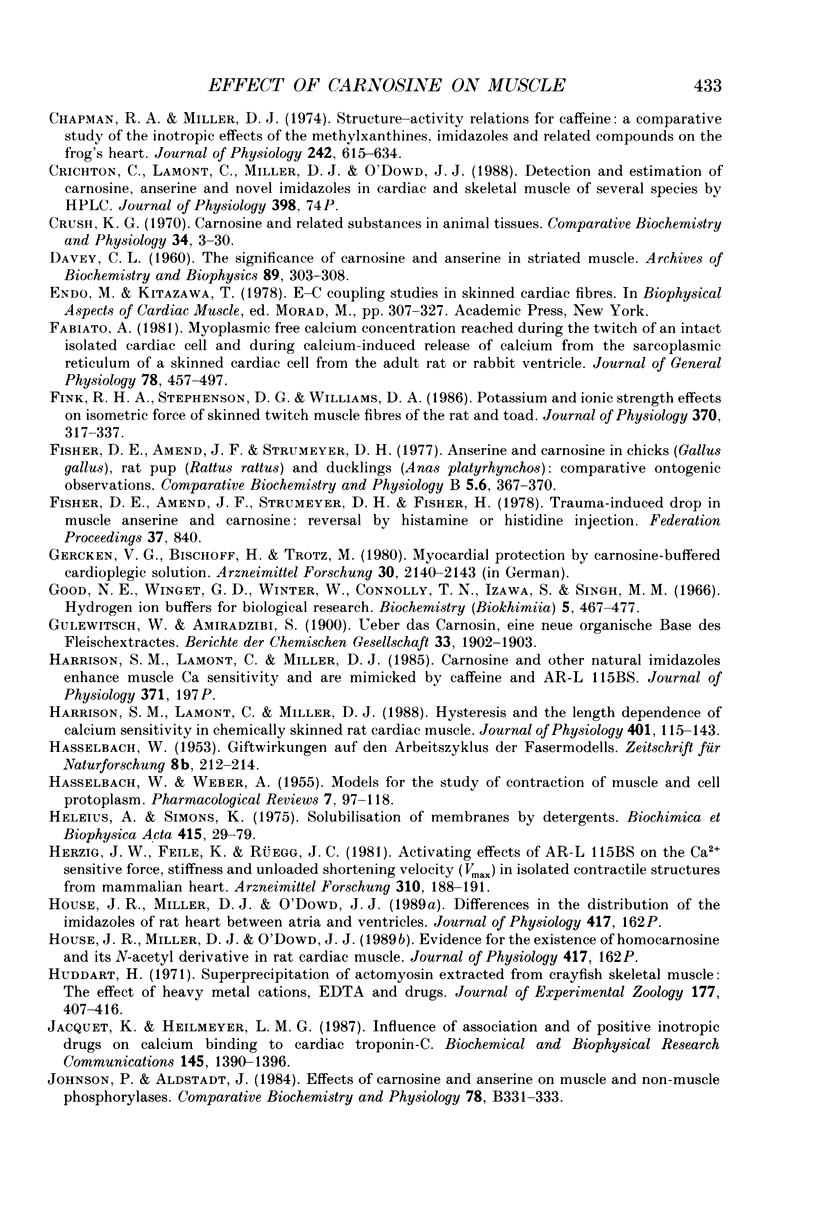
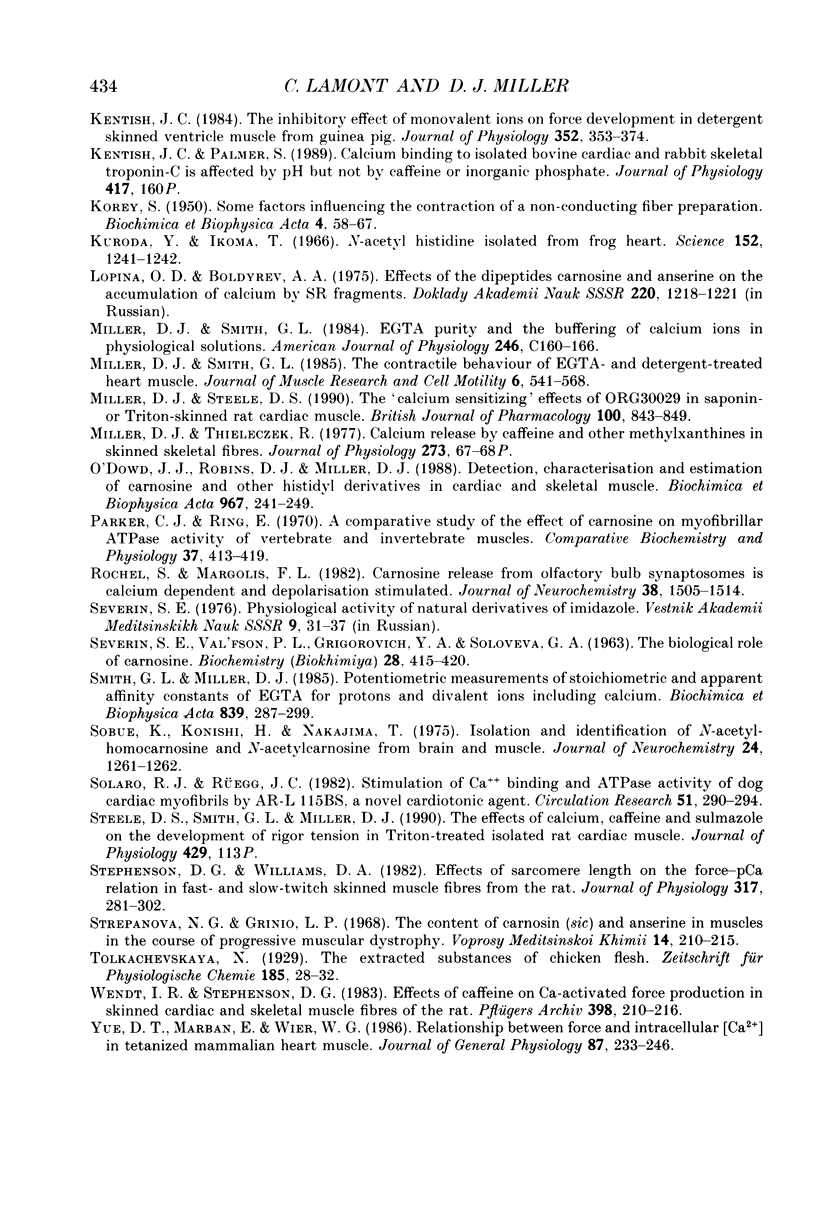
Selected References
These references are in PubMed. This may not be the complete list of references from this article.
- Altringham J. D., Johnston I. A. Effects of phosphate on the contractile properties of fast and slow muscle fibres from an Antarctic fish. J Physiol. 1985 Nov;368:491–500. doi: 10.1113/jphysiol.1985.sp015871. [DOI] [PMC free article] [PubMed] [Google Scholar]
- Avena R. M., Bowen W. J. Effects of carnosine and anserine on muscle adenosine triphosphatases. J Biol Chem. 1969 Mar 25;244(6):1600–1604. [PubMed] [Google Scholar]
- Brown C. E. Interactions among carnosine, anserine, ophidine and copper in biochemical adaptation. J Theor Biol. 1981 Jan 21;88(2):245–256. doi: 10.1016/0022-5193(81)90073-4. [DOI] [PubMed] [Google Scholar]
- Burton R. F. The composition of animal cells: solutes contributing to osmotic pressure and charge balance. Comp Biochem Physiol B. 1983;76(4):663–671. doi: 10.1016/0305-0491(83)90375-9. [DOI] [PubMed] [Google Scholar]
- Chapman R. A., Miller D. J. Structure-activity relations for caffeine: a comparative study of the inotropic effects of the methylxanthines, imidazoles and related compounds on the frog's heart. J Physiol. 1974 Nov;242(3):615–634. doi: 10.1113/jphysiol.1974.sp010726. [DOI] [PMC free article] [PubMed] [Google Scholar]
- Crush K. G. Carnosine and related substances in animal tissues. Comp Biochem Physiol. 1970 May 1;34(1):3–30. doi: 10.1016/0010-406x(70)90049-6. [DOI] [PubMed] [Google Scholar]
- DAVEY C. L. The significance of carnosine and anserine in striated skeletal muscle. Arch Biochem Biophys. 1960 Aug;89:303–308. doi: 10.1016/0003-9861(60)90059-x. [DOI] [PubMed] [Google Scholar]
- Fabiato A. Myoplasmic free calcium concentration reached during the twitch of an intact isolated cardiac cell and during calcium-induced release of calcium from the sarcoplasmic reticulum of a skinned cardiac cell from the adult rat or rabbit ventricle. J Gen Physiol. 1981 Nov;78(5):457–497. doi: 10.1085/jgp.78.5.457. [DOI] [PMC free article] [PubMed] [Google Scholar]
- Fink R. H., Stephenson D. G., Williams D. A. Potassium and ionic strength effects on the isometric force of skinned twitch muscle fibres of the rat and toad. J Physiol. 1986 Jan;370:317–337. doi: 10.1113/jphysiol.1986.sp015937. [DOI] [PMC free article] [PubMed] [Google Scholar]
- Fisher D. E., Amend J. F., Strumeyer D. H. Anserine and carnosine in chicks (Gallus gallus) rat pups (Rattus rattus) and ducklings (Anas platyrhynchos): comparative ontogenetic observations. Comp Biochem Physiol B. 1977;56(4):367–370. doi: 10.1016/0305-0491(77)90232-2. [DOI] [PubMed] [Google Scholar]
- Gercken G., Bischoff H., Trotz M. Myokardprotektion durch eine Carnosin-gepufferte kardioplegische Lösung. Arzneimittelforschung. 1980;30(12):2140–2143. [PubMed] [Google Scholar]
- Good N. E., Winget G. D., Winter W., Connolly T. N., Izawa S., Singh R. M. Hydrogen ion buffers for biological research. Biochemistry. 1966 Feb;5(2):467–477. doi: 10.1021/bi00866a011. [DOI] [PubMed] [Google Scholar]
- HASSELBACH W., WEBER A. Models for the study of the contraction of muscle and of cell protoplasm. Pharmacol Rev. 1955 Mar;7(1):97–117. [PubMed] [Google Scholar]
- Harrison S. M., Lamont C., Miller D. J. Hysteresis and the length dependence of calcium sensitivity in chemically skinned rat cardiac muscle. J Physiol. 1988 Jul;401:115–143. doi: 10.1113/jphysiol.1988.sp017154. [DOI] [PMC free article] [PubMed] [Google Scholar]
- Helenius A., Simons K. Solubilization of membranes by detergents. Biochim Biophys Acta. 1975 Mar 25;415(1):29–79. doi: 10.1016/0304-4157(75)90016-7. [DOI] [PubMed] [Google Scholar]
- Herzig J. W., Feile K., Rüegg J. C. Activating effects of AR-L 115 BS on the Ca2+ sensitive force, stiffness and unloaded shortening velocity (Vmax) in isolated contractile structures from mammalian heart muscle. Arzneimittelforschung. 1981;31(1A):188–191. [PubMed] [Google Scholar]
- Huddart H. Superprecipitation of actomyosin extracted from crayfish skeletal muscle: the effect of heavy metal cations, EDTA and drugs. J Exp Zool. 1971 Aug;177(4):407–415. doi: 10.1002/jez.1401770403. [DOI] [PubMed] [Google Scholar]
- Jaquet K., Heilmeyer L. M., Jr Influence of association and of positive inotropic drugs on calcium binding to cardiac troponin C. Biochem Biophys Res Commun. 1987 Jun 30;145(3):1390–1396. doi: 10.1016/0006-291x(87)91592-0. [DOI] [PubMed] [Google Scholar]
- Johnson P., Aldstadt J. Effects of carnosine and anserine on muscle and non-muscle phosphorylases. Comp Biochem Physiol B. 1984;78(2):331–333. doi: 10.1016/0305-0491(84)90039-7. [DOI] [PubMed] [Google Scholar]
- KOREY S. Some factors influencing the contractility of a non-conducting fiber preparation. Biochim Biophys Acta. 1950 Jan;4(1-3):58–67. doi: 10.1016/0006-3002(50)90009-6. [DOI] [PubMed] [Google Scholar]
- Kentish J. C. The inhibitory effects of monovalent ions on force development in detergent-skinned ventricular muscle from guinea-pig. J Physiol. 1984 Jul;352:353–374. doi: 10.1113/jphysiol.1984.sp015296. [DOI] [PMC free article] [PubMed] [Google Scholar]
- Kuroda Y., Ikoma T. N-acetylhistidine isolated from frog heart. Science. 1966 May 27;152(3726):1241–1242. doi: 10.1126/science.152.3726.1241. [DOI] [PubMed] [Google Scholar]
- Lopina O. D., Boldyrev A. A. Vliianie dipeptidov karnozina i anzerina na akkumuliatsiiu Ca2+ fragmentami sarkoplazmaticheskogo retikuluma. Dokl Akad Nauk SSSR. 1975;220(5):1218–1221. [PubMed] [Google Scholar]
- Macefield G., Gandevia S. C., Burke D. Perceptual responses to microstimulation of single afferents innervating joints, muscles and skin of the human hand. J Physiol. 1990 Oct;429:113–129. doi: 10.1113/jphysiol.1990.sp018247. [DOI] [PMC free article] [PubMed] [Google Scholar]
- Miller D. J., Smith G. L. EGTA purity and the buffering of calcium ions in physiological solutions. Am J Physiol. 1984 Jan;246(1 Pt 1):C160–C166. doi: 10.1152/ajpcell.1984.246.1.C160. [DOI] [PubMed] [Google Scholar]
- Miller D. J., Smith G. L. The contractile behaviour of EGTA- and detergent-treated heart muscle. J Muscle Res Cell Motil. 1985 Oct;6(5):541–567. doi: 10.1007/BF00711914. [DOI] [PubMed] [Google Scholar]
- Miller D. J., Steele D. S. The 'calcium sensitising' effects of ORG30029 in saponin- or Triton-skinned rat cardiac muscle. Br J Pharmacol. 1990 Aug;100(4):843–849. doi: 10.1111/j.1476-5381.1990.tb14102.x. [DOI] [PMC free article] [PubMed] [Google Scholar]
- Miller D. J., Thieleczek R. Calcium release by caffeine and other methylxanthines in skinned skeletal muscle fibres [proceedings]. J Physiol. 1977 Dec;273(2):67P–68P. [PubMed] [Google Scholar]
- O'Dowd J. J., Robins D. J., Miller D. J. Detection, characterisation, and quantification of carnosine and other histidyl derivatives in cardiac and skeletal muscle. Biochim Biophys Acta. 1988 Nov 17;967(2):241–249. doi: 10.1016/0304-4165(88)90015-3. [DOI] [PubMed] [Google Scholar]
- Parker C. J., Jr, Ring E. A comparative study of the effect of carnosine on myofibrillar-ATPase activity of vertebrate and invertebrate muscles. Comp Biochem Physiol. 1970 Dec 1;37(3):413–419. doi: 10.1016/0010-406x(70)90569-4. [DOI] [PubMed] [Google Scholar]
- Rochel S., Margolis F. L. Carnosine release from olfactory bulb synaptosomes is calcium-dependent and depolarization-stimulated. J Neurochem. 1982 Jun;38(6):1505–1514. doi: 10.1111/j.1471-4159.1982.tb06626.x. [DOI] [PubMed] [Google Scholar]
- Severin S. E. Fiziologicheskaia aktivnost' priodnykh proizvodnykh imidazola. Vestn Akad Med Nauk SSSR. 1976;(9):31–37. [PubMed] [Google Scholar]
- Smith G. L., Miller D. J. Potentiometric measurements of stoichiometric and apparent affinity constants of EGTA for protons and divalent ions including calcium. Biochim Biophys Acta. 1985 May 8;839(3):287–299. doi: 10.1016/0304-4165(85)90011-x. [DOI] [PubMed] [Google Scholar]
- Sobue K., Konishi H., Nakajima T. Isolation and identification of N-acetylhomocarnosine and N-acetylcarnosine from brain and muscle. J Neurochem. 1975 Jun;24(6):1261–1262. doi: 10.1111/j.1471-4159.1975.tb03908.x. [DOI] [PubMed] [Google Scholar]
- Solaro R. J., Rüegg J. C. Stimulation of Ca++ binding and ATPase activity of dog cardiac myofibrils by AR-L 115BS, a novel cardiotonic agent. Circ Res. 1982 Sep;51(3):290–294. doi: 10.1161/01.res.51.3.290. [DOI] [PubMed] [Google Scholar]
- Stepanova N. G., Grinio L. P. Issledovanie dipeptidov pri progressivnoi myshechnoi distrofii. Vopr Med Khim. 1968 Mar-Apr;14(2):210–214. [PubMed] [Google Scholar]
- Stephenson D. G., Williams D. A. Calcium-activated force responses in fast- and slow-twitch skinned muscle fibres of the rat at different temperatures. J Physiol. 1981 Aug;317:281–302. doi: 10.1113/jphysiol.1981.sp013825. [DOI] [PMC free article] [PubMed] [Google Scholar]
- Wendt I. R., Stephenson D. G. Effects of caffeine on Ca-activated force production in skinned cardiac and skeletal muscle fibres of the rat. Pflugers Arch. 1983 Aug;398(3):210–216. doi: 10.1007/BF00657153. [DOI] [PubMed] [Google Scholar]


